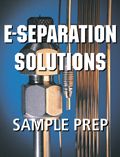Ask The Editor: CE Sensitivity
What methods can be used to overcome the low concentration sensitivity of capillary electrophoresis for separation and detection of trace-level analytes in complex matrices?
An LCGC reader recently submitted the following question:
What methods can be used to overcome the low concentration sensitivity of capillary electrophoresis for separation and detection of trace-level analytes in complex matrices?
LCGC's Steve Brown provides us with the following answer:
Low concentration sensitivity is a major obstacle in capillary electrophoresis (CE) analyses, especially with UV detection, and it is caused by the required low injection volumes and short detection pathlength. A few examples of preconcentration approaches include on-line concentration for the CE analysis of biological fluids (1); on- and in-capillary preconcentration methods based on solid-phase extraction (2); in-line preconcentration using a cellulose acetate-coated porous joint in the capillary (3); on-line preconcentration of protein using a cellulose acetate-coated porous membrane at one end of a CE column (4); membrane preconcentration for CE?mass spectrometry (MS) sequencing of peptides (5); solid-phase microextraction (SPME) and on-line sample stacking for the analysis of pesticides in foods (6); and on-line preconcentration using monolithic methacrylate polymers for the CE analysis of S-propranolol (7). Britz-McKibbin and colleagues (8) compared various preconcentration methods for steroid CE analysis and noted that four major on-line preconcentration strategies had been used: sample stacking, transient isotachophoresis, sweeping, and dynamic pH junction - the mechanisms vary depending on electrolyte properties such as conductivity, co-ion mobility, additive concentration, and buffer pH. These examples just scratch the surface of the body of literature available on this topic.
Reference
(1) S. Sentellas, L. Puignou, and M.T. Galceran, J. Sep. Sci. 25(15-17), 975-987 (2002).
(2) L. Saavedra and C. Barbas, J. Biochem. Biophys. Methods 70(2), 289-297 (2007).
(3) R. Umeda and X.-Z. Wu, Anal. and Bioanal. Chem 382(3), 848-852 (2005).
(4) B. Yang, F. Zhang, H. Tian, and Y. Guan, J. Chrom. A 1117(2), 214-218 (2006).
(5) S. Naylor and A.J. Tomlinson, Talanta 45(4), 603-612 (1998).
(6) J. Hernández-Borges, A. Cifuentes, F.J. GarcÃa-Montelongo, and M.A. RodrÃguez-Delgado, Electrophoresis 26(4/5), 980-989 (2005).
(7) N.E. Baryla and N.P. Toltl, Analyst 128, 1009-1012 (2003).
(8) P. Britz-McKibbin, T. Ichihashi, K. Tsubota, D.D.Y. Chen, and S. Terabe, J. Chrom. A 1013, 65-76 (2003).
Questions?
LCGC technical editor Steve Brown will answer your technical questions. Each month, one question will be selected to appear in this space, so we welcome your submissions. Please send all questions to the attention of "Ask the Editor" at lcgcedit@lcgcmag.com. We look forward to hearing from you.
LCGC’s Year in Review: Highlights in Liquid Chromatography
December 20th 2024This collection of technical articles, interviews, and news pieces delves into the latest innovations in LC methods, including advance in high performance liquid chromatography (HPLC), ultrahigh-pressure liquid chromatography (UHPLC), liquid chromatography–mass spectrometry (LC–MS), and multidimensional LC.
Using LC-MS/MS to Measure Testosterone in Dried Blood Spots
December 19th 2024Testosterone measurements are typically performed using serum or plasma, but this presents several logistical challenges, especially for sample collection, storage, and transport. In a recently published article, Yehudah Gruenstein of the University of Miami explored key insights gained from dried blood spot assay validation for testosterone measurement.
